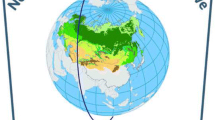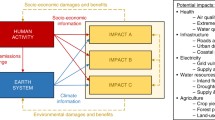Abstract
In this paper, we explore the regional nature of global environmental challenges. We take a broad approach by examining the scientific foundation that is needed to support policy and decision making and identifying some of the most important barriers to progress that are truly scale-dependent. In so doing, we hope to show that understanding global environmental changes requires understanding a number of intrinsically regional phenomena, and that successful decision making likewise requires an integrated approach that accounts for a variety of regional Earth system processes—which we define to include both human activities and environmental systems that operate or interact primarily at sub-continental scales. Understanding regional processes and phenomena, including regional decision-making processes and information needs, should thus be an integral part of the global change research agenda. To address some of the key issues and challenges, we propose an integrated regional modeling approach that accounts for the dynamic interactions among physical, ecological, biogeochemical, and human processes and provides relevant information to regional decision makers and stakeholders.



Similar content being viewed by others
References
Bennaceur K, Gielen D (2010) Energy technology modelling of major carbon abatement options. Int J Green Gas Control 4(2):309–315. doi:10.1016/j.ijggc.2009.10.002
Bhardwaj AK, Zenone T, Jasrotia P, Robertson GP, Chen J, Hamilton SK (2010) Water and energy footprints of bioenergy crop production on marginal lands. Glob Chang Biol Bioenergy 3(3):208–222
CCSP (2008) The effects of climate change on agriculture, land resources, water resources, and biodiversity in the United States. A Report by the U.S. Climate Change Science Program and the Subcommittee on Global Change Research. U.S. Department of Agriculture, Washington, DC., USA, 362 pp
Clarke L, Emonds J, Krey V, Richels R, Rose S, Massimo T (2009) International climate policy architectures: overview of the EMF 22 International Scenarios. Energy Econ 31:S64–S81. doi:10.1016/j.eneco.2009.10.013
Dolan KA, Hurtt GC, Chambers J, Dubayah R, Frolking S (2011) Using ICESat’s geoscience laser altimeter system to assess large scale forest disturbance caused by Hurricane Katrina. Remote Sens Environ 115(1):86–96. doi:10.1016/j.rse.2010.08.007
Dooley JJ, Trabucchi C, Patton L (2010a) Design considerations for financing a national trust to advance the deployment of geologic CO2 storage and motivate best practices. Int J Green Gas Control 4(2):381–387. doi:10.1016/j.ijggc.2009.09.009
Dooley JJ, Dahowski RT, Davidson CL (2010b) CO2-driven enhanced oil recovery as a stepping stone to what? PNNL-19557. Pacific Northwest National Laboratory, Richland
Edmonds JA et al (2001) Global energy technology strategy: addressing climate change–initial findings from a public-private collaboration. Battelle Memorial Institute, Washington, 60 pp
Edmonds JA et al (2007) Global energy technology strategy: addressing climate change–phase 2 findings from a public-private sponsored research program. Battelle Memorial Institute, College Park, 142 pp
Harte J, El-Gasseir M (1978) Energy and water. Science 199(10):623–634
Houghton RA (1993) Is carbon accumulating in the northern temperate zone? Global Biogeochem Cycles 7(3):611–617. doi:10.1029/93GB01163
IPCC (2007a) Summary for policymakers. In: Parry ML, Canziani OF, Palutikof JP, van der Linden PJ, Hanson CE (eds) Climate change 2007: impacts, adaptation and vulnerability. Contribution of Working Group II to the Fourth Assessment Report of the Intergovernmental Panel on Climate Change. Cambridge University Press, Cambridge, pp 7–22
IPCC (2007b) Climate change 2007: synthesis report. Contribution of Working Groups I, II and III to the Fourth Assessment Report of the Intergovernmental Panel on Climate Change [Core Writing Team, Pachauri RK, Reisinger A (eds)]. IPCC, Geneva, Switzerland, 104 pp
Israelsson PH, Chow AC, Adams EE (2010) An updated assessment of the acute impacts of ocean carbon sequestration by direct injection. Int J Green Gas Control 4(2):262–271
Janetos AC, Clarke L, Collins W, Ebi K, Edmonds J, Foster I, Jacoby HJ, Judd K, Leung L, Newell R, Ojima D, Pugh G, Sanstad A, Schultz P, Stevens R, Weyant J, Wilbanks T, Knotek M, Malone E (2009) Science challenges and future directions: climate change integrated assessment research. Dept. of Energy, Washington, 80 pp
Loarie SR, Lobell DB, Asner GP, Mu Q, Field CB (2011) Direct impacts on local climate of sugar-cane expansion in Brazil. Nat Clim Chang 1:105–109
Malewitz J (2011) Persistent drought threatens Texas oil industry, Stateline, October 7, 2011. http://www.stateline.org/live/details/story?contentId=605095
McMillan HK, Brasington J (2008) End-to-end flood risk assessment: a coupled model cascade with uncertainty estimation. Water Resour Res 44(W03419):doi:10.1029/2007WR005995
Millennium Ecosystem Assessment (2005) Ecosystems and human well-being: synthesis. Island Press, Washington
Morgan MG, Cantor R, Clark WC, Fisher A, Jacoby AD, Janetos AC, Kinzig AP, Melillo J, Street RB, Wilbanks TJ (2005) Learning from the U.S. National Assessment of Climate Change. Environ Sci Technol 39:9023–9032
National Assessment Synthesis Team (NAST) (2000) Climate change impacts on the United States: the potential consequences of climate variability and change, overview report. US Global Change Research Program, Washington
National Research Council (2010) America’s climate choices: panel on adapting to the impacts of climate change. National Acadamies Press, Washington, 293 pp
Nelson GC, Bennett E, Berhe AA, Cassman KG, DeFries R, Dietz T, Dobson A et al (2005) Chapter 7—Drivers of change in ecosystem condition and services. In: S.R. Carpenter, et al. (Eds) Ecosystems and human well-being: Scenarios. Findings of the Scenarios Working Group of the Millennium Ecosystem Assessment, vol. 2. Island Press, Washington, pp 173–222
O'Neill BC et al (2012) The effect of urbanization on energy use in India and China in the iPETS model. Energy Econ. doi:10.1016/j.eneco.2012.04.004
Pappenberger F, Beven KJ, Hunter NM, Bates PD, Gouweleeuw BT, Thielen J, de Roo APJ (2005) Cascading model uncertainty form medium range weather forecasts (10 days) through a rainfall-runoff model to flood inundation predictions within the European Flood Forecasting System (EFFS). Hydrol Earth Syst Sci 9(4):381–393
Raffa KF, Aukema BH, Bentz BJ, Carroll BAL, Hicke JA, Turner MG, Rome WH (2008) Cross-scale drivers of natural disturbances prone to anthropogenic amplification: the dynamics of bark beetle eruptions. BioScience 58(6):501–517
Ramanathan V, Crutzen PJ, Kiehl JT, Rosenfeld D (2001) Aerosols, climate and the hydrologic cycle. Science 294:2119–2124. doi:10.1126/science.1064034
Rausch S, Rutherford TF (2010) Computation of equilibria in OLG models with many heterogeneous households. Comput Econ 36(2):171–189
Reilly J, Paltsev S (2009) Biomass energy and competition for land. In: Hertel T, Rose S, Tol R (eds) Economic analysis of land use in global climate change policy. Routledge, UK, pp 184–207
Rice JS, Moss RH, Runci PJ, Anderson KL, Malone EL (2012) Incorporating stakeholder decision support needs into an integrated regional Earth system model. Mitig Adapt Strateg Glob Chang. doi:10.1007/s11027-011-9345-3
Root T, Schneider S (2002) Strategic cyclical scaling: bridging five orders of magnitude scale gaps in climatic and ecological studies. Integr Assess 3(2–3):188–200
Skaggs R, Hibbard KA (2012) Climate and energy-water-land system interactions: Technical Report to the U.S. Department of Energy in support of the National Climate Assessment. Report No. PNNL-21185. Pacific Northwest National Laboratory, Richland, WA, p 152
Skamarock WC, Klemp JB, Dudhia J, Gill DO, Barker DM, Duda MG, Huang X-Y, Want W, Powers JG (2008) A description of the advanced research WRF version 3. NCAR Technical Note 475+STR. 113. Pp
Tans PP, Fung IY, Takahashi T (1990) Observational constraints on the global atmospheric CO2 budget’. Science 247:1431–1438
U.S. Environmental Protection Agency (EPA) (2011) Regulatory impact analysis: final national ambient air quality standard for Ozone. 87 pp
Van Vuuren DP, Edmonds J, Kainuma M, Riahi K, Thomson A, Hibbard K, Hurtt G, Kram T, Krey V, Lamarque J-F, Masui T, Meinshausen M, Nakicenovic N, Smith SJ, Rose SK (2011) The representative concentration pathways: an overview. Clim Chang 109:5–31
Voldoire A, Eickhout B, Schaeffer M, Royer J-F, Chauvin F (2007) Climate simulation of the twenty-first century with interactive land-use changes. Clim Dyn 29(2–3):177–193. doi:10.1007/s00382-007-028-y
Wang Y, Leung LR, McGregor JL, Lee D-K, Wang W-C, Ding Y, Kimura F (2004) Regional climate modeling: progress, challenges and prospects. J Meteorol Soc Jpn 82(6):1599–1628
Wise MA, Calvin KV, Thomson AM, Clarke LE, Bond-Lamberty B, Sands RD, Smith SJ, Janetos AC, Edmonds JA (2009) Implications of limiting CO2 concentrations for land use and energy. Science 324(5931):1183–1186
Author information
Authors and Affiliations
Corresponding author
Rights and permissions
About this article
Cite this article
Hibbard, K.A., Janetos, A.C. The regional nature of global challenges: a need and strategy for integrated regional modeling. Climatic Change 118, 565–577 (2013). https://doi.org/10.1007/s10584-012-0674-3
Received:
Accepted:
Published:
Issue Date:
DOI: https://doi.org/10.1007/s10584-012-0674-3




